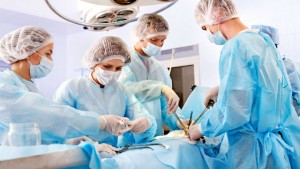Home » Commentary » Opinion » Public health needs a jab of private productivity
· The Australian
 Since the 2013 election, the national conversation has been dominated by calls to revive the mojo of the 1980s and undertake economic reform to repair government budgets. Yet according to some analysts, South Australian Premier Jay Weatherill’s plan to raise the GST to fund public health and education services is “doable”. The real question, however, is whether we should do this kind of so-called ‘tax reform’ at all.
Since the 2013 election, the national conversation has been dominated by calls to revive the mojo of the 1980s and undertake economic reform to repair government budgets. Yet according to some analysts, South Australian Premier Jay Weatherill’s plan to raise the GST to fund public health and education services is “doable”. The real question, however, is whether we should do this kind of so-called ‘tax reform’ at all.
Public hospitals and public schools are the two areas of the public sector that have remained largely quarantined from the reform agenda of the last 30 years. Opening other government utilities — such as electricity, ports, and transport — to competition and privatisation has improved performance in those crucial areas of the economy. But social services such as hospitals and schools, which consume huge amounts of government expenditure, continue to be sheltered from reform and propped up by taxpayers.
Pouring billions more GST revenue into public hospitals would represent the antithesis of economic reform, which is meant to be about generating higher ‘outputs’ for the same, or even less, amount of ‘inputs’.
Taxes should not be hiked to fund inefficient services in a sector that is ripe for restructuring to improve outcomes. Anyone familiar with the health policy debate should know current health funding is not being used efficiently.
Inefficiencies range from expensive hospital admissions that could have been prevented by lower-cost community based care, to over-servicing due to unnecessary and sometimes unsafe surgical procedures. Moreover, if public hospitals employed the more efficient management and workplace practices common in private hospitals, elective waiting times could be reduced.
This is just the tip of the efficiency problem in public hospitals. Clinical staff are employed on favorable terms and conditions under centralised, state-wide ‘sweetheart’ agreements negotiated by public sector unions. Salaries and wages salaries account for two-thirds of hospital budgets.
According to the latest Productivity Commission Report on Government Services, national recurrent expenditure on public hospitals topped $44 billion in 2014, up from $28 billion in 2005. Over this period, labour costs grew by 56%, and non-labour costs by 54%.
Public hospitals face rising demand due to the ageing and growing population, rising rates of chronic illness, and new medical technologies creating more things to do for more patients. But the crucial question is whether the system is productive, and if the higher amounts being spent are producing a proportionate increase in services.
The one answer we have to this question suggests not. The 2013 Queensland Commission of Audit headed by Peter Costello found that in the previous five years, funding for the state’s public hospitals increased by 43 per cent but “activity” —the number of patients treated and operations performed —increased by only 17 per cent.
No wonder the former Federal Treasurer disagrees with his predecessor Paul Keating, who wants a smaller GST rise hypothecated into state coffers. Costello has remained true to the bi-partisan spirit of economic reform that prevailed in Canberra during the period of the Hawke Labor Government, and has spoken out against the Turnbull Government’s apparent willingness to take a GST rate hike to the 2016 federal election.
The flagged rise in the GST is difficult to reconcile with the Prime Minister’s statement that he wants to lead a government committed to economic reform. Financial pressure is the one thing that is most likely to force the state governments down the alternative path canvassed by the Harper Competition Review, which is to extend and apply the reform principles of choice, competition, and private provision to the public health sector.
Before they jump on the ‘tax more, spend more’ bandwagon, all members of the political class should also ask themselves how fair it is to make average voters pay higher prices for essential goods and services to preserve the cossetted positions of some of the highest paid professionals in the nation.
Average doctor salaries in public hospitals top $188,000 a year, and the average nurse earns $91,000. Taxpayer-funded employment in this part of the public service should be called out for what it really is — a form of middle class welfare. There is no reason white-collar doctors and nurses (and teachers for that matter) should continue to be treated differently to how blue-collar electricity, ports, and transport workers were long ago treated to achieve genuine economic reform.
Jeremy Sammut is a research fellow at The Centre for Independent Studies, and co-authored with David Gadiel the research report How the NSW Coalition Should Govern Health: Strategies for Microeconomic Reform.
Public health needs a jab of private productivity